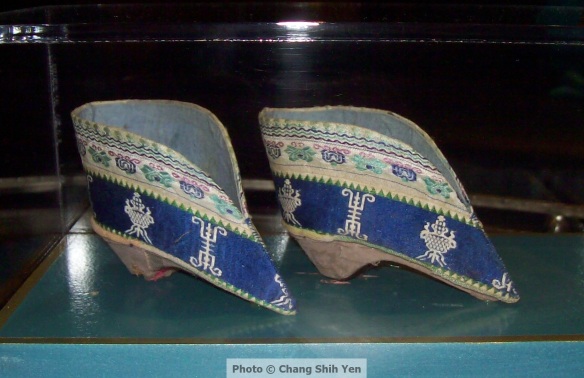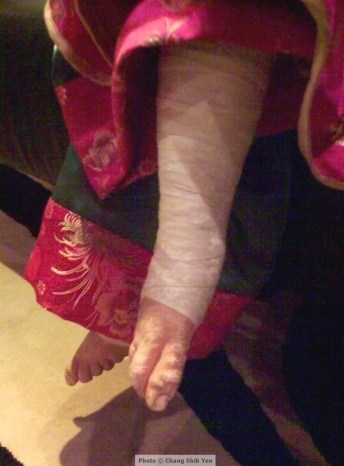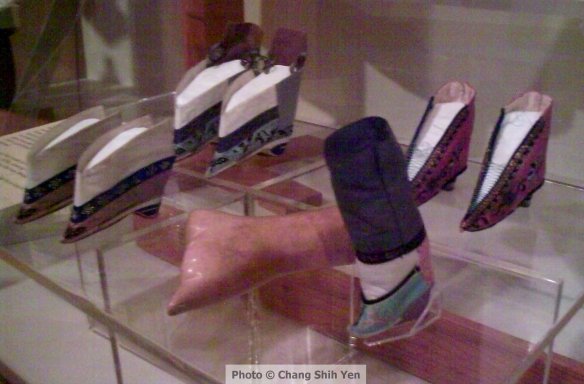Last month, I wrote about huge, gigantic feet. This month, I am writing about the opposite – super tiny feet. Humans suffer a lot of pain for the sake of beauty. I just think of all the pain and blisters I have had from wearing uncomfortable shoes or from stuffing my feet into too-small shoes. This is nothing compared to the old practice of Chinese foot binding. Since Chinese new year is on 10th February this year, I thought I would write about the ancient Chinese practice of foot binding and the special shoes that women with bound feet have to wear.
I feel a connection to this practice as my maternal great-great grandmother, who was born in the 1870s, had bound feet. Personally, I think it’s ironic that my great-great grandmother had tiny bound feet, but in just a few generations, my unbound feet have grown so large that I struggle to find women’s shoes in Asia.
The Chinese custom of foot binding began in the tenth century. Foot binding was widespread during the Song Dynasty (960 – 1279 AD) and continued for another 1000 years. Foot binding started for little girls when they were aged between 2 – 5 years old. Little girls’ feet were tightly bound with long pieces of cloth bandages to stop their growth. This practice was excruciatingly painful because it deliberately broke the girls’ toes and the arch of their foot. Girls and women with bound feet would never be able to run and could hardly walk. Instead, bound feet forced them to totter around, a walk that was considered attractive.
In January, I wrote about Robert Wadlow whose super huge feet was a hazard to his health and contributed to his death. Similarly, Chinese women with bound feet also had to be careful as they could suffer deadly infections from foot binding. The cloths that bound the feet had to be changed and washed regularly to prevent infections. For the rich, this was done once a day. For poorer people, this would happen 2 or 3 times a week. It was done by either a professional foot binder (yes, that occupation actually existed in the past!) or by an elder female relative. Apart from infections, other problems included rotting flesh in the feet and the stink associated with that.
Foot binding was a status symbol. It was a symbol of beauty, wealth, elegance and even sexuality. Chinese women who wanted to marry well or into money had to have bound feet as Chinese men did not want to marry women with large feet. Families who could bind the feet of their daughters were seen as rich as this meant they could afford servants, since daughters with bound feet would never be able to work and would need help to move around.
The ideal goal in foot binding was to have feet as small as 3 inches (7.6cm) long. These were called ‘golden lotus’ feet because the tiny feet resembled a lotus bud. Feet that were 4 inches (10cm) long were also acceptable and these were called silver lotus. Women with bound feet wore special shoes called ‘three inch golden lotus shoes’ (三寸金蓮鞋). These shoes were specially made, generally made of fabric, such as silk with cotton soles, and always beautifully embroidered.

These are not baby shoes, but shoes for women with bound feet. Close-up of a pair of golden lotus shoes.
There were various attempts to ban foot binding in the 1800s and early 1900s, though they were not very successful. This practice took years to die out. The last factory in China that made shoes for bound feet finally closed in the late 1990s because there was no longer any demand for the shoes as women with bound feet are dying off.
Nowadays, lotus shoes can only be seen in museums, or are sold as souvenir items. They are from a bygone era, as the practice of foot binding has become a relic of the past.



wow
I am amazed that girls let someone do that to there feet! It must have really hurt!!
That was the price of beauty, and it was normal back then.
oh those poor girls! And there poor little feet!
How did they actually break the girls toes?
I think the toes were bent over and then bound so tightly that they were not able to grow.